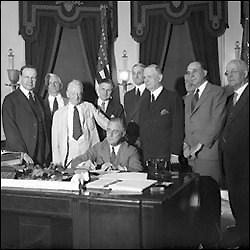By Pam Martens and Russ Martens: July 19, 2016

President Bill Clinton Laughs It Up as He Signs the Repeal of the Glass-Steagall Act, November 12, 1999
Breaking up the dangerous banks on Wall Street that are gambling with their taxpayer-backstopped insured deposits by restoring the Glass-Steagall Act is now a part of the newly adopted platforms of both the Democrat and Republican parties. Under a restored Glass-Steagall Act, banks holding insured deposits would not be allowed to affiliate with Wall Street investment banks and brokerage firms that regularly underwrite risky securities and engage in trillions of dollars of derivative gambles. It would effectively put an end to the idea that these complex banks are too-big-to-fail because the life savings of small savers holding insured deposits in the bank would be at risk.
Bernie Sanders’ supporters pushed the Democratic Party to include the provision in its platform. Today’s media spin is that Trump & Company added it in hopes of picking up some Sanders’ supporters who have vowed not to vote for Hillary Clinton.
What has been lost in the frenzy of political posturing is that there already exists a bi-partisan bill in the Senate to restore the Glass-Steagall Act. It’s called the “21st Century Glass-Steagall Act of 2015” and is co-sponsored by progressive Senator Elizabeth Warren and Republican Senator John McCain among others.
McCain’s eyes were opened wide on the need to restore the Glass-Steagall Act when he sat as ranking member of the U.S. Senate’s Permanent Subcommittee on Investigations under the Chairmanship of Senator Carl Levin. That Subcommittee effectively became the missing U.S. Justice Department in exposing serial frauds by the Wall Street mega banks.
After the Subcommittee released a scathing 307-page report in 2012 on JPMorgan Chase’s use of insured deposits to make high-risk gambles in exotic derivatives in London and lose $6.2 billion in the process (the London Whale scandal), Senator McCain had this to say in his opening remarks at the hearing on the matter:
“This case represents another shameful demonstration of a bank engaged in wildly risky behavior. The ‘London Whale’ incident matters to the federal government because the traders at JPMorgan were making risky bets using excess deposits, portions of which were federally insured. These excess deposits should have been used to provide loans for main-street businesses. Instead, JPMorgan used the money to bet on catastrophic risk.”
According to documents released by the Senate, JPMorgan Chase had gamed the system in multiple ways. On January 16, 2012, JPMorgan’s Chief Investment Office held $458 billion notional (face amount) in domestic and foreign credit default swap indices. Of the $458 billion, $115 billion was in an index of corporations with junk bond ratings, which the bank was not allowed to own. According to the Office of the Comptroller of the Currency, JPMorgan “transferred the market risk of these positions into a subsidiary of an Edge Act corporation, which took most of the losses.” An Edge Act corporation refers to the ability of a bank to obtain a special charter from the Federal Reserve. By establishing an Edge Act corporation, U.S. banks are able to engage in investments not available under standard banking laws.
The London Whale is far from the only example we’ve seen of Wall Street using insured deposits backed by the taxpayer to make wild gambles or engage in transactions that are against the public interest since the frankenbanks were bailed out after collapsing the financial system in 2008.
Last year the Wall Street Journal’s Jenny Strasburg reported that “Bank of America Corp. for years used its government-backed U.S. banking subsidiary to finance billions of dollars in controversial trades that helped hedge funds and other clients avoid taxes, according to internal documents and people familiar with the matter.”
Two men who have repeatedly stood in the way of restoring the Glass-Steagall Act by asserting a perceived threat that London could replace New York as the global center of banking are Senator Chuck Schumer of New York and former New York City Mayor Michael Bloomberg, whose multi-billionaire status stems from the Bloomberg data terminals he leases to frankenbanks.
As we wrote on July 8, 2013:
“On November 1, 2006, the Wall Street Journal published an opinion piece by Schumer and Mayor Michael Bloomberg titled, ‘To Save New York, Learn from London.’ Keep in mind that this opinion piece came exactly one year before Wall Street would begin its apocalyptic meltdown from lax regulation, secret off balance sheet holdings, rigged accounting, and too cozy a relationship with Washington.
“But on November 1, 2006, Schumer and Bloomberg weren’t looking at the real, festering hubris on Wall Street that would shortly bring the country within a hairsbreadth of the Great Depression, they were pounding the table for looser regulation of Wall Street and tighter reins of those who would hold them accountable in a court of law.
“The Bloomberg administration had hired the consulting firm, McKinsey & Company, to study and issue a report on making sure New York City remained the financial services capital of the world. Schumer and Bloomberg were worried about competitiveness at a time when the screaming problem was systemic corruption.
“Two of the biggest problems identified by the duo in their Wall Street Journal opinion piece were ‘overregulation’ and ‘frivolous litigation.’ They wrote that ‘our regulatory bodies are often competing to be the toughest cop on the street,’ while ‘the British regulatory body seems to be more collaborative and solutions-oriented.’
“Got that – ‘toughest cop on the street.’ As the public would soon learn in short order, those tough cops let Bernie Madoff slip through their fingers despite reams of evidence handed to them; ignored the creative accounting at Lehman Brothers and Citigroup until both firms blew up; allowed massive and imprudent derivatives exposure at AIG until it collapsed; and permitted insured bank deposits to be imperiled across Wall Street by allowing lobbyists to bully legislators into repealing the Glass-Steagall Act which had prevented Wall Street casinos from endangering the national economy since its enactment during the Great Depression.
“So out of touch were Schumer and Bloomberg with the reality of what was really happening on Wall Street at the time that they saw not a collapse in corporate ethics but a ‘worrisome trend of corporate leaders focusing inordinate time on compliance minutiae rather than innovative strategies for growth, for fear of facing personal financial penalties from overzealous regulators.’ ”
The frankenbank, or universal banking model, is now teetering across Europe as well as in the U.S. Earlier this month, the Wall Street Journal tallied up the losses and ran this sobering headline: “The Big-Bank Bloodbath: Losses Near Half a Trillion Dollars.” According to the author of the article, David Reilly: “Since the start of 2016, 20 of the world’s bigger banks have lost a quarter of their combined market value. Added up, it equals about $465 billion, according to FactSet data.”
The Glass-Steagall Act became law in 1933, four years after the 1929 crash made it abundantly clear that Wall Street investment banks could not be trusted to hold the savings of small depositors. The legislation protected this country’s financial system for 66 years until its repeal in 1999 under the Bill Clinton administration, which was packed with Wall Street cronies. It took just nine years from its repeal for Wall Street to flame out in the greatest crash since the Great Depression.
The question today is not whether Glass-Steagall should be re-enacted but whether Congress will have the courage to act before the next crash forces its hand.



